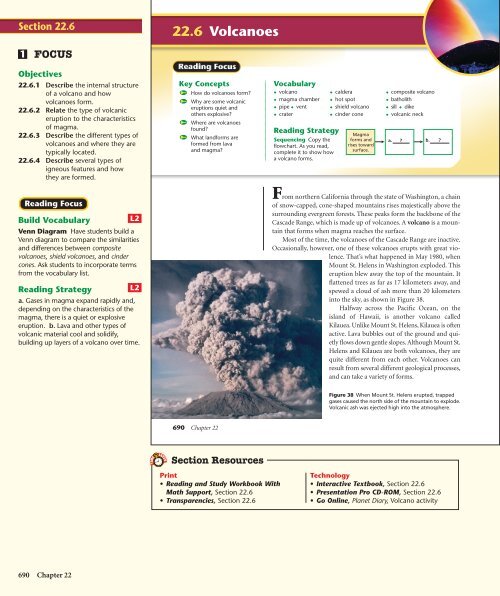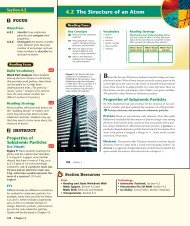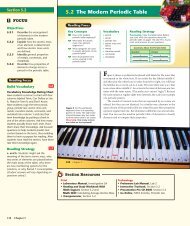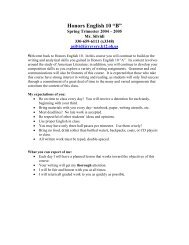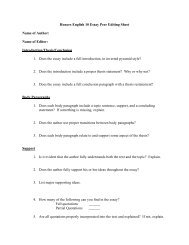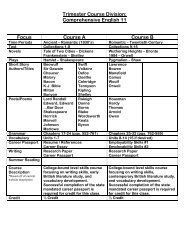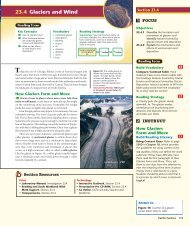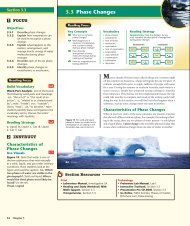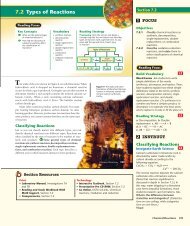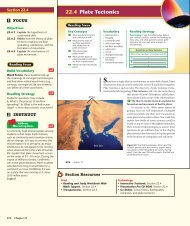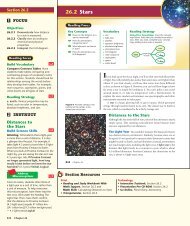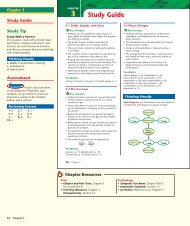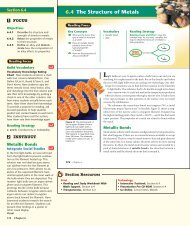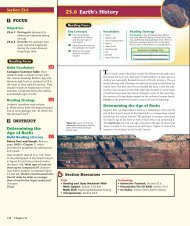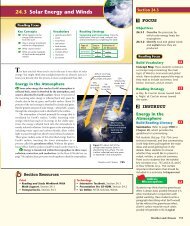Create successful ePaper yourself
Turn your PDF publications into a flip-book with our unique Google optimized e-Paper software.
Section <strong>22.6</strong><br />
1<br />
FOCUS<br />
Objectives<br />
<strong>22.6</strong>.1 Describe the internal structure<br />
of a volcano and how<br />
volcanoes form.<br />
<strong>22.6</strong>.2 Relate the type of volcanic<br />
eruption to the characteristics<br />
of magma.<br />
<strong>22.6</strong>.3 Describe the different types of<br />
volcanoes and where they are<br />
typically located.<br />
<strong>22.6</strong>.4 Describe several types of<br />
igneous features and how<br />
they are formed.<br />
Reading Focus<br />
Build Vocabulary<br />
Venn Diagram Have students build a<br />
Venn diagram to compare the similarities<br />
and differences between composite<br />
volcanoes, shield volcanoes, and cinder<br />
cones. Ask students to incorporate terms<br />
from the vocabulary list.<br />
Reading Strategy<br />
690 Chapter 22<br />
L2<br />
L2<br />
a. Gases in magma expand rapidly and,<br />
depending on the characteristics of the<br />
magma, there is a quiet or explosive<br />
eruption. b. Lava and other types of<br />
volcanic material cool and solidify,<br />
building up layers of a volcano over time.<br />
<strong>22.6</strong> <strong>Volcanoes</strong><br />
Key Concepts<br />
How do volcanoes form?<br />
Why are some volcanic<br />
eruptions quiet and<br />
others explosive?<br />
Where are volcanoes<br />
found?<br />
What landforms are<br />
formed from lava<br />
and magma?<br />
690 Chapter 22<br />
Section Resources<br />
Print<br />
• Reading and Study Workbook With<br />
Math Support, Section <strong>22.6</strong><br />
• Transparencies, Section <strong>22.6</strong><br />
Vocabulary<br />
◆ volcano<br />
◆ magma chamber<br />
◆ pipe ◆ vent<br />
◆ crater<br />
Reading Strategy<br />
Sequencing Copy the<br />
flowchart. As you read,<br />
complete it to show how<br />
a volcano forms.<br />
◆ caldera<br />
◆ hot spot<br />
◆ shield volcano<br />
◆ cinder cone<br />
Magma<br />
forms and<br />
rises toward<br />
surface.<br />
◆ composite volcano<br />
◆ batholith<br />
◆ sill ◆ dike<br />
◆ volcanic neck<br />
a. ? b. ?<br />
From northern California through the state of Washington, a chain<br />
of snow-capped, cone-shaped mountains rises majestically above the<br />
surrounding evergreen forests. These peaks form the backbone of the<br />
Cascade Range, which is made up of volcanoes. A volcano is a mountain<br />
that forms when magma reaches the surface.<br />
Most of the time, the volcanoes of the Cascade Range are inactive.<br />
Occasionally, however, one of these volcanoes erupts with great violence.<br />
That’s what happened in May 1980, when<br />
Mount St. Helens in Washington exploded. This<br />
eruption blew away the top of the mountain. It<br />
flattened trees as far as 17 kilometers away, and<br />
spewed a cloud of ash more than 20 kilometers<br />
into the sky, as shown in Figure 38.<br />
Halfway across the Pacific Ocean, on the<br />
island of Hawaii, is another volcano called<br />
Kilauea. Unlike Mount St. Helens, Kilauea is often<br />
active. Lava bubbles out of the ground and quietly<br />
flows down gentle slopes. Although Mount St.<br />
Helens and Kilauea are both volcanoes, they are<br />
quite different from each other. <strong>Volcanoes</strong> can<br />
result from several different geological processes,<br />
and can take a variety of forms.<br />
Figure 38 When Mount St. Helens erupted, trapped<br />
gases caused the north side of the mountain to explode.<br />
Volcanic ash was ejected high into the atmosphere.<br />
Technology<br />
• Interactive Textbook, Section <strong>22.6</strong><br />
• Presentation Pro CD-ROM, Section <strong>22.6</strong><br />
• Go Online, Planet Diary, Volcano activity
Formation of a Volcano<br />
The process that leads to a volcanic eruption begins deep inside Earth.<br />
Under certain conditions, small amounts of mantle rock can<br />
melt, forming liquid magma. The magma rises upward through the<br />
crust, erupting at the surface as a volcano. Magma rises because it is<br />
less dense than the solid rock around and above it.<br />
How a Volcano Erupts What causes a volcanic eruption? The<br />
process is similar to what happens when you quickly open a bottle of<br />
soda that has been shaken. Like the soda in the bottle, magma is under<br />
pressure and contains dissolved gases. In the case of magma, the gases<br />
include carbon dioxide and water vapor. As magma approaches the<br />
surface, lower pressure allows the gases in magma to expand rapidly.<br />
An eruption occurs when the gases bubble out through a crack in the<br />
crust, propelling magma to the surface.<br />
Structure of a Volcano Before an eruption, magma often collects<br />
in a pocket called a magma chamber, shown in Figure 39. Magma<br />
slowly accumulates in the magma chamber until enough pressure<br />
builds up to start an eruption. Then, magma rises to the surface in a<br />
narrow, vertical channel called a pipe.<br />
An opening in the ground where magma escapes to the surface is<br />
called a vent. Often there is one central vent at the top of a volcano. Sometimes<br />
there are other vents that open along a volcano’s side. At the top of<br />
the central vent in most volcanoes is a bowl-shaped pit called a crater.<br />
After an eruption, a volcano’s magma chamber and main vent may<br />
empty of magma, creating a hollow shell. If this shell collapses inward,<br />
it creates a huge depression, called a caldera, at the top of the volcano.<br />
Crater<br />
Lava<br />
Customize for Inclusion Students<br />
Learning Disabled<br />
For students with difficulty absorbing concepts<br />
by reading, use Figure 39 as a visual aid as you<br />
describe the path of magma through a volcano.<br />
Vent<br />
Pipe<br />
Figure 39 When a volcanic<br />
mountain erupts, magma under<br />
pressure is forced upward from<br />
the magma chamber. It passes<br />
through the pipe, and out the<br />
vent. Magma flows onto the<br />
surface as lava. Predicting What<br />
might happen to a volcano if its<br />
pipe became plugged with<br />
hardened magma?<br />
Magma chamber<br />
691<br />
Be sure students understand which part is which<br />
and the order in which magma travels through<br />
each part.<br />
2<br />
INSTRUCT<br />
Formation of a<br />
Volcano<br />
Build Science Skills<br />
Using an Analogy Have students<br />
expand upon the soda bottle analogy<br />
presented in How a Volcano Erupts.<br />
Review the analogy to be sure students<br />
understand that the water in the<br />
magma is being compared to the<br />
carbon dioxide in the soda. The<br />
presence of water in magma can cause<br />
explosive, steam-filled eruptions. As<br />
magma erupts, the pressure drops. This<br />
drop in pressure allows the hot water to<br />
expand into steam. This expansion can<br />
cause very explosive eruptions. Ask,<br />
How does opening the bottle relate<br />
to magma rising to the surface?<br />
(The pressure drops in both cases.)<br />
Why does the gas expand when the<br />
pressure drops? ( , with<br />
temperature constant, as pressure<br />
decreases, volume increases) What<br />
volcanic rock is similar to the frothy<br />
part of the soda outburst? (Pumice)<br />
Logical<br />
FYI<br />
P1V1<br />
T1<br />
P2V2<br />
T2<br />
L2<br />
There is another similarity between a<br />
steam-filled, explosive volcanic eruption<br />
and a shaken bottle of soda. In both<br />
cases, what comes out is often frothy and<br />
filled with bubbles. When this molten<br />
volcanic froth is ejected, it cools and<br />
solidifies in the air before it lands on the<br />
ground. These bits of solidified froth are<br />
called pyroclastic deposits, and they have<br />
a large range in size and appearance.<br />
The most common pyroclastic deposit is<br />
ash, which has very small grains. Because<br />
ash is so small, it can be thrown high into<br />
the atmosphere, where it can be carried<br />
all around Earth.<br />
In some pyroclastic deposits, like<br />
pumice, the bubbles of the molten froth<br />
are retained as pockets of air called<br />
vesicles. Pumice has so much air trapped<br />
in vesicles that it will float on top of<br />
water. Some pyroclastic deposits contain<br />
a black glass called obsidian. This occurs<br />
when the magma cools so fast that<br />
crystals do not have time to form, and<br />
the atoms solidify in a random,<br />
amorphous structure.<br />
Answer to . . .<br />
Figure 39 Pressure will build up until<br />
the volcano erupts explosively.<br />
Earth’s Interior 691
Section <strong>22.6</strong> (continued)<br />
Quiet and Explosive<br />
Eruptions<br />
Build Reading Literacy<br />
Identify Main Idea/Details Refer to<br />
page 98D in Chapter 4, which provides<br />
the guidelines for identifying main ideas<br />
and details.<br />
Have students read Quiet and Explosive<br />
Eruptions. Ask them to read the key<br />
concept aloud. Then, have students find<br />
the details that support this key concept.<br />
Ask, Which characteristics of the<br />
magma determine how the volcano<br />
erupts? (Temperature, water content, and<br />
silica content)<br />
Verbal<br />
FYI<br />
692 Chapter 22<br />
L1<br />
Magma melts for different reasons in<br />
different regions. Beneath hot spots, the<br />
upwelling rock comes from deep within<br />
Earth and may be a few hundred degrees<br />
hotter than surrounding rock, causing it<br />
to melt more easily. Beneath mid-ocean<br />
ridges, the opening plates pull up rock<br />
from below to fill the void, and the<br />
release of pressure causes melt to begin<br />
to form. The magma trickles upward,<br />
forming small magma chambers directly<br />
beneath the ridge. Subduction zone<br />
volcanoes occur because of water. The<br />
subducting plates carry water down into<br />
the mantle with them. Much of this<br />
water dehydrates off of the slab at a<br />
depth of about 100 km, and rises up into<br />
the overlying wedge of mantle rock. This<br />
water lowers the melting point of the<br />
rock, causing magma to form, which rises<br />
up to form subduction zone volcanoes.<br />
Figure 40 Lava may flow in the<br />
form of rough chunks called aa,<br />
or smooth coils called pahoehoe.<br />
Formulating Hypotheses<br />
Develop a hypothesis to account<br />
for the difference in texture<br />
between pahoehoe and aa.<br />
Figure 41 Mt. Kilauea in Hawaii<br />
erupts quietly, producing lowviscosity<br />
lava flows.<br />
692 Chapter 22<br />
pahoehoe aa<br />
Facts and Figures<br />
Pyroclastic Flows Under certain conditions,<br />
volcanic eruptions can be very dangerous.<br />
One of the most deadly volcanic hazards is a<br />
pyroclastic flow, which is a hot cloud of gas<br />
and dust that rushes down the sides of a<br />
volcano at speeds of up to 150 kilometers per<br />
Quiet and Explosive Eruptions<br />
A volcanic eruption like that of Mount St. Helens has the force<br />
of a powerful explosion. But in other volcanic eruptions, lava<br />
flows gently over the surface. <strong>Volcanoes</strong> erupt explosively<br />
or quietly, depending on the characteristics of the magma.<br />
Magma can vary in viscosity, the resistance to flow.<br />
Magma with high viscosity is thick and resists flowing.<br />
Magma with low viscosity is thin and flows easily.<br />
There are three main factors that determine the viscosity<br />
of magma: temperature, water content, and silica<br />
content. Higher temperatures lower the viscosity of magma,<br />
so it flows more easily. The presence of water in magma also<br />
helps it flow more easily. Magma that is high in silica has high<br />
viscosity. The silicon and oxygen atoms in silica are held together with<br />
strong bonds. The silica in magma acts like glue, preventing the<br />
magma from flowing easily.<br />
Quiet Eruptions <strong>Volcanoes</strong> that have very hot, low-silica magma<br />
generally erupt quietly. In a quiet eruption, lava erupts in a stream of<br />
low-viscosity lava, called a lava flow. Lava flows from a quiet eruption<br />
can travel for great distances. Quiet eruptions produce two different<br />
kinds of lava, as shown in Figure 40. Hot, fast-moving lava with a<br />
ropelike surface is called pahoehoe (pah HOH ee hoh ee). Cooler, slowmoving<br />
lava with a chunky, crumbly appearance is called aa (AH ah).<br />
Explosive Eruptions High-silica magma produces explosive<br />
eruptions. Thick magma can clog a volcanic pipe, causing enormous<br />
pressure to build up. Trapped steam inside the volcano adds to the<br />
pressure, as was the case in the eruption of Mount St. Helens. When<br />
the volcano finally explodes, lava and hot gases are hurled outward. The<br />
lava solidifies very quickly and shatters into pieces of different sizes.<br />
These particles range in size from fine dust and ash, to pebble-sized<br />
cinders, to bombs—chunks of lava that can be the size of a small car.<br />
hour. With temperatures of up to 700C, a<br />
pyroclastic flow can burn everything in its<br />
path. One of the most famous pyroclastic<br />
flows destroyed the town of Herculaneum<br />
during the eruption of Mt. Vesuvius in A.D. 79.
Eurasian Plate<br />
Indo-Australian<br />
Plate<br />
KEY<br />
Convergent boundary<br />
Divergent boundary<br />
Transform boundary<br />
Uncertain plate boundary<br />
Volcano<br />
Philippine<br />
Plate<br />
Juan de Fuca Plate<br />
Pacific Plate<br />
Cocos<br />
Plate<br />
North American<br />
Plate<br />
Nazca<br />
Plate<br />
Caribbean<br />
Plate<br />
Location and Types of <strong>Volcanoes</strong><br />
Most volcanoes occur along plate boundaries or at hot spots in<br />
the crust. <strong>Volcanoes</strong> often form along a converging plate boundary<br />
where an oceanic plate is subducted into the mantle. As it sinks<br />
through the mantle, the plate causes melting. Magma forms and rises<br />
to the surface. As Figure 42 shows, many volcanoes have formed along<br />
the trenches that rim the Pacific Ocean. This region is called the “Ring<br />
of Fire.” <strong>Volcanoes</strong> also form along a diverging plate boundary where<br />
magma rises to fill the gap between two separating plates.<br />
Some volcanoes occur at hot spots, as shown in the Concepts in<br />
Action pages. A hot spot is a region where hot rock extends from deep<br />
within the mantle to the surface.<br />
Different types of volcanic eruptions produce different types of volcanoes.<br />
Each type is named for its shape or interior structure. The<br />
three major types of volcano are shield volcanoes, cinder cones, and<br />
composite volcanoes. A quiet eruption of low-viscosity lava produces<br />
a wide, flat volcano called a shield volcano. If an eruption is entirely<br />
ash and cinders, the result will be a small, steep-sided volcano called a<br />
cinder cone. A volcano that forms from explosive eruptions that produce<br />
a combination of lava and ash is called a composite volcano.<br />
What is a shield volcano?<br />
South American<br />
Plate<br />
Scotia<br />
Plate<br />
Eurasian Plate<br />
Arabian<br />
Plate<br />
African<br />
Plate<br />
Antarctic Plate<br />
Figure 42 Except for hotspot<br />
volcanoes, most of the<br />
world’s volcanoes form near<br />
plate boundaries.<br />
Relating Cause and Effect Why<br />
are there volcanoes in the middle<br />
of the Atlantic Ocean?<br />
For: Activity on volcanoes<br />
Visit: PHSchool.com<br />
Web Code: ccc-3226<br />
Earth’s Interior 693<br />
Location and Types<br />
of <strong>Volcanoes</strong><br />
Use Visuals<br />
Figure 42 Point out that most<br />
volcanoes occur at the boundaries<br />
between plates. Mid-ocean ridges are<br />
not marked by individual volcano<br />
symbols on this diagram, but are places<br />
where magma erupts at Earth’s surface,<br />
forming oceanic crust. Ask, Which<br />
volcanoes are formed from melting<br />
slabs of subducting oceanic crust?<br />
(Students should point to volcano symbols<br />
at convergent boundaries.) Where are<br />
volcanoes located in the United<br />
States? (Alaska, Hawaii, the west coast)<br />
Visual<br />
FYI<br />
L1<br />
Most volcanoes are inactive during a<br />
single person’s lifetime. However, most of<br />
these volcanoes are considered dormant,<br />
or sleeping, and not extinct. They will still<br />
erupt again, but not during our lifetimes.<br />
This is another reminder that geologic<br />
events occur over much longer time<br />
scales than humans normally experience.<br />
Find links to additional activities and<br />
have students monitor phenomena<br />
that affect Earth and its residents.<br />
Answer to . . .<br />
Figure 40 The difference in texture<br />
between pahoehoe and aa is mainly due<br />
to the different temperatures of the two<br />
lavas and the speed at which they flow.<br />
Pahoehoe is hotter and faster moving<br />
than aa. Also, escaping gas within aa<br />
helps to produce a rough surface.<br />
Figure 42 Many of these volcanoes<br />
are located along the Mid-Atlantic<br />
ridge, a divergent boundary where<br />
magma is rising from the mantle to<br />
form new oceanic crust.<br />
A wide, flat volcano<br />
produced by quiet<br />
eruptions of low-viscosity lava<br />
Earth’s Interior 693
Types of <strong>Volcanoes</strong><br />
Background<br />
Composite and cinder cone volcanoes<br />
form when magma is rich in silicates,<br />
the primary source of which is melting<br />
continental crust. These types of<br />
volcanoes are often found above<br />
subduction zones, where magma from<br />
the melting wedge of mantle above the<br />
subducted slab must travel through a<br />
thick wedge of continental crust to<br />
reach the surface, contact melting<br />
occurs, and silica-rich magma becomes<br />
incorporated in the volcanic arc.<br />
Similarly, when hot spots are located<br />
beneath continental crust, cinder cones<br />
and composite volcanoes again result.<br />
However, hot spots in the ocean melt<br />
only silica-poor oceanic crust. In these<br />
cases, shield volcanoes are produced.<br />
Build Science Skills<br />
694 Chapter 22<br />
L2<br />
L2<br />
Inferring<br />
Purpose Students will<br />
infer the type of volcano<br />
based on the characteristics<br />
of the rock it produced.<br />
Materials several samples of<br />
pumice, obsidian, ropy basalt, and<br />
angular rhyolite per group<br />
Class Time 15–20 minutes<br />
Procedure After reading the Concepts<br />
in Action feature, have students work in<br />
groups to study volcanic rock samples.<br />
For each rock, ask, What type of<br />
volcano do you think this rock most<br />
likely came from? (Basalt is most<br />
associated with shield volcanoes, rhyolite<br />
with cinder cones or composite volcanoes.)<br />
Expected Outcome Using the<br />
information about pumice and obsidian<br />
on p. 695, students can deduce that<br />
these samples came from near the<br />
surface of a lava flow. The contact with<br />
air caused quick cooling in both cases.<br />
Students can infer that the ropy basalt<br />
came from the type of runny basaltic<br />
flow associated with shield volcanoes.<br />
Rhyolite has a higher silica content than<br />
the basalt, and is much lighter in color<br />
and “ashier” in appearance. Many<br />
rhyolite samples also contain vesicles.<br />
The gases trapped in viscous, silica-rich<br />
magma produce the explosive eruptions<br />
associated with composite volcanoes<br />
and cinder cones.<br />
Kinesthetic, Logical<br />
Types of <strong>Volcanoes</strong><br />
<strong>Volcanoes</strong> have different types of magma. The viscosity<br />
of the magma plays a large part in determining a<br />
volcano’s ultimate shape and appearance.<br />
<strong>Volcanoes</strong> most commonly occur at three major<br />
locations on Earth—mid-ocean ridges,<br />
subduction zones, and hot spots. Each type of<br />
volcanic region produces a different kind of<br />
volcano because of the type of magma<br />
that exists there. The three main types of<br />
volcano are shield volcanoes, composite<br />
volcanoes, and cinder cones. Most<br />
volcanoes that form above subduction<br />
zones, for example, are composite<br />
volcanoes. In contrast, many volcanoes that<br />
form above hot spots are shield volcanoes.<br />
Shapes of <strong>Volcanoes</strong><br />
Each type of volcano has a different shape. The<br />
shape is determined by the kind of lava, ash, and<br />
cinders that erupt from the volcano’s vent, and<br />
especially the viscosity of the lava.<br />
Shield volcano<br />
Shield volcanoes are broad,<br />
gently sloping volcanic mountains.<br />
Their eruptions consist of hot,<br />
flowing basaltic lava that travels<br />
a long way before it solidifies.<br />
694 Chapter 22<br />
Facts and Figures<br />
Yellowstone Hot Spot A special case of hot<br />
spot volcanism occurs when the hot spot is<br />
beneath a continent. One such hot spot is<br />
located in Yellowstone National Park. The<br />
continent acts like a thick lid, and it is hard for<br />
the hot spot to break through. When this does<br />
happen, a lot of continental rock gets melted as<br />
well, giving the magma a composition rich in<br />
silica. The result can be very explosive eruptions.<br />
Composite volcano<br />
Composite volcanoes are tall with<br />
steep sides that are built up from<br />
layers of viscous lava, ash, and<br />
volcanic bombs. They often have<br />
secondary vents.<br />
Cinder cone<br />
Cinder cones are small with<br />
steep sides. They form from<br />
ash and cinders that are<br />
ejected into the air and fall<br />
back onto the volcano.<br />
Gigantic eruptions at Yellowstone 2.1, 1.35, and<br />
0.64 million years ago blanketed the western<br />
half of North America with ash. Fortunately,<br />
these giant explosions are very rare, and most<br />
hot spot activity at Yellowstone consists of hot<br />
springs of water. However, Yellowstone is still<br />
geologically active and will likely have another<br />
large explosion in the future.
Volcanic Rocks<br />
The silica and water content of magma<br />
help to determine whether an eruption is<br />
quiet or explosive and how viscous the<br />
lava is when hot. When the lava cools,<br />
different types of rock are formed.<br />
Pumice<br />
Pumice is a light, spongelike<br />
rock usually found at<br />
the surface of a lava flow.<br />
It consists of a mass of gas<br />
bubbles frozen in fragile<br />
volcanic glass and minerals.<br />
Hot-spot <strong>Volcanoes</strong><br />
A hot spot is a rising column of hot<br />
rock that extends from deep within<br />
the mantle to the surface. Hot spots<br />
often exist in the middle of plates.<br />
Because the hot spot stays in one<br />
place while the plate moves over it,<br />
a chain of volcanoes is formed over<br />
time.<br />
A very ancient hot spot under<br />
the Pacific plate has, over millions of<br />
years, produced the Hawaiian<br />
Islands.<br />
Kilauea erupting<br />
A shield volcano,<br />
Kilauea is the<br />
youngest volcano<br />
on the island of<br />
Hawaii and one<br />
of the most active<br />
in the world.<br />
Video Field Trip<br />
Mountains of Fire<br />
Extinct volcanoes form<br />
chains of islands<br />
Plate carries active<br />
volcanoes away and they<br />
become extinct as new<br />
island begins to form.<br />
After students have viewed the Video Field Trip,<br />
ask the following questions: Where do the most<br />
violent volcanic eruptions typically occur? (Near<br />
Going Further<br />
Lava bombs<br />
Lava bombs form from a glob<br />
of magma that is blown explosively<br />
into the air. Bombs are<br />
usually at least 10 cm in diameter,<br />
and can be much larger.<br />
Vent<br />
Rising<br />
magma<br />
Obsidian<br />
Obsidian is a dense,<br />
volcanic glass formed<br />
from lava that has<br />
cooled too quickly for<br />
minerals to crystallize.<br />
Volcano erupts<br />
over stationary<br />
hot spot and<br />
creates an island.<br />
■ Use library or Internet resources to research a<br />
volcano located on another planet or moon.<br />
Write a one-page report<br />
describing the volcano that<br />
you select. Include an<br />
explanation of how this<br />
volcano compares with<br />
volcanoes on Earth.<br />
■ Take a Discovery Channel<br />
Video Field Trip by watching<br />
“Mountains of Fire.”<br />
Video Field Trip<br />
Earth’s Interior 695<br />
subduction zones, where Earth’s tectonic plates are<br />
pushed together and one plate slips under another.)<br />
What is a composite volcano? (A volcano with<br />
alternating layers of different materials.) What is a<br />
shield volcano? (A wide, flat volcano that produces<br />
quiet eruptions of low-viscosity lava.) Name a third<br />
major kind of volcano. (Cinder cone volcanoes.)<br />
Going Further<br />
L3<br />
<strong>Volcanoes</strong> occur on several planets and<br />
moons in the solar system besides Earth,<br />
including Venus, Mars, Io, and possibly<br />
Triton. In addition, there is evidence of<br />
ancient volcanic activity on Mercury and<br />
Earth’s moon. Some of the most wellknown<br />
volcanoes include Olympus<br />
Mons, Arsia Mons, Pavonis Mons,<br />
Ascraeus Mons, and Elysium Mons on<br />
Mars; Theia Mons, Sif Mons, and Maat<br />
Mons on Venus; and Pele, Ra, Loki, and<br />
Prometheus on Io. Have interested<br />
students research volcanoes on other<br />
planets or moons and present photos to<br />
the class.<br />
Visual<br />
Earth’s Interior 695
Section <strong>22.6</strong> (continued)<br />
Other Igneous<br />
Features<br />
Many students have the misconception<br />
that the only way igneous rocks are<br />
formed is when molten lava flows onto<br />
Earth’s surface. After students read Other<br />
Igneous Features, have them work in<br />
groups to create a visual describing five<br />
ways igneous rocks can form. (In lava<br />
flows at the surface, dikes, sills, batholiths,<br />
and volcanic necks)<br />
Visual, Group<br />
ASSESS<br />
3<br />
Evaluate<br />
Understanding<br />
Using Figure 41, ask students what type<br />
of volcano most likely produced this<br />
type of lava. (Shield volcano)<br />
Reteach<br />
Use Figure 39 to explain the main<br />
features of a volcano.<br />
Students have many eruptions to choose<br />
from, including Mt. Mazama (Crater<br />
Lake), Oregon, around 5000 B.C.; Mt.<br />
Vesuvius, Italy, in A.D. 79; Mt. Fuji, Japan,<br />
in 1707; Tambora, Indonesia, in 1815;<br />
Krakatoa, Indonesia, in 1883; Mt. Pelée,<br />
Martinique, in 1902; Mt. Katmai, Alaska,<br />
in 1912; Mt. St. Helens in 1980;<br />
Mt. Pinatubo, Philippines, in 1991;<br />
and Montserrat in 1995.<br />
If your class subscribes to<br />
the Interactive textbook, use it to review<br />
key concepts in Section <strong>22.6</strong>.<br />
Section <strong>22.6</strong> Assessment<br />
L2<br />
L2<br />
L1<br />
1. Magma is formed from melted rock within<br />
the mantle. The magma is under pressure and<br />
less dense than the solid rock around it. The<br />
magma is forced upward through the crust,<br />
erupting at the surface.<br />
2. Magma with a low silica content results in<br />
gentle eruptions. Magma with a high silica<br />
content can lead to explosive eruptions.<br />
3. <strong>Volcanoes</strong> form above converging plate<br />
boundaries (where a plate is subducted into<br />
the mantle) and at diverging boundaries<br />
696 Chapter 22<br />
Figure 43 Ship Rock in New<br />
Mexico is a volcanic neck. It<br />
formed when the soft rock<br />
around a volcano’s pipe wore<br />
away, revealing hard, igneous<br />
rock. The long ridge extending<br />
from the volcanic neck is a dike.<br />
Section <strong>22.6</strong> Assessment<br />
Reviewing Concepts<br />
1. Describe the process that leads up to the<br />
eruption of a volcano.<br />
2. How does the silica content of magma<br />
affect how explosive an eruption is?<br />
3. Explain why volcanoes form in certain<br />
regions of Earth’s surface.<br />
4. Describe four types of intrusive igneous<br />
rock features.<br />
Critical Thinking<br />
5. Relating Cause and Effect What condition<br />
must exist in a volcano for a caldera to form?<br />
696 Chapter 22<br />
(where magma rises to fill the gap left by two<br />
separating plates). Hot spot volcanoes form<br />
from columns of hot rock that have risen up<br />
through the mantle to the surface.<br />
4. Batholiths are large rock masses that form<br />
the core of many mountain ranges. A sill is<br />
hardened lava squeezed into a crack that is<br />
parallel to existing rock layers. A dike is<br />
hardened lava in a crack that cuts across<br />
existing rock layers. A volcanic neck is an<br />
igneous structure formed from lava that<br />
hardened in a volcano’s pipe.<br />
Other Igneous Features<br />
Sometimes magma does not reach the surface, but<br />
cools and hardens in the crust. This magma forms<br />
intrusive igneous rock that may eventually be forced<br />
upward and exposed at Earth’s surface. Igneous<br />
features formed by magma include batholiths,<br />
sills, dikes, and volcanic necks. Lava plateaus are<br />
features formed of extrusive igneous rock.<br />
A batholith is the largest type of intrusive<br />
igneous rock mass. Batholiths often form the core<br />
of a mountain range, such as the Sierra Nevada<br />
range in California. Magma sometimes squeezes into a crack between<br />
layers of rock and then hardens. If the crack is parallel to existing rock<br />
layers, the magma hardens into a structure called a sill. If the crack<br />
cuts across rock layers, the hardened magma forms a dike. When<br />
magma hardens in a volcano’s pipe, a structure called a volcanic neck<br />
may form, as shown in Figure 43.<br />
The largest lava flows don’t come from individual volcanoes.<br />
Rather, large amounts of easily-flowing lava sometimes erupt from a<br />
cluster of long, thin cracks in the crust. This lava may spread out over<br />
an enormous area before solidifying. After many years, layers of hardened<br />
lava may form a high, level area called a lava plateau. An example<br />
is the Columbia Plateau, which has an average thickness of more than<br />
1 kilometer and covers an area of nearly 200,000 square kilometers in<br />
the Pacific Northwest.<br />
6. Predicting What would eventually happen,<br />
as a result of plate movement, to a volcano<br />
that formed over a hot spot?<br />
7. Comparing and Contrasting What is the<br />
difference between a dike and a sill?<br />
Descriptive Paragraph Use library or<br />
Internet resources to research a major volcanic<br />
eruption. Write a paragraph about the<br />
eruption including when and where it took<br />
place and the type of volcano involved.<br />
5. The magma chamber and main vent must<br />
be empty after an eruption, creating an empty<br />
shell that can collapse inward.<br />
6. As the plate moves, the volcano would be<br />
carried away from the hot spot, and the<br />
volcano would no longer be active.<br />
7. Both are structures formed from magma that<br />
hardens in cracks in layers of rock. If the crack is<br />
parallel to existing rock layers, the structure is<br />
called a sill. If the crack cuts across rock layers,<br />
the structure is called a dike.


